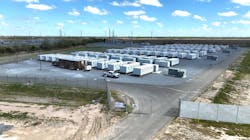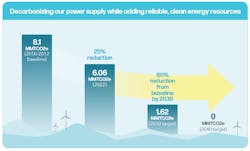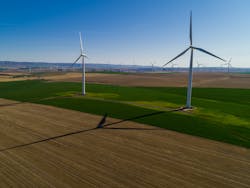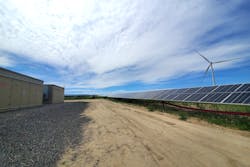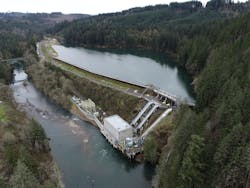Portland General Electric Bolsters Reliability with Battery Energy Storage Systems
During the 2021 legislative session, Oregon state lawmakers passed an ambitious decarbonization framework requiring investor-owned utilities to reduce greenhouse gas emissions associated with electricity sold to Oregon retail customers. House Bill 2021 (HB 2021) mandates an 80% reduction in emissions from baseline amounts by 2030, 90% by 2035 and 100% by 2040. Additionally, the law prohibits the construction of new generating facilities producing electric power from fossil fuels.
As the state’s largest electric utility serving more than 900,000 customers — and a key supporter of Oregon’s clean energy legislation — Portland General Electric (PGE) has a steep road ahead to execute on these clean energy targets. Estimates from the utility’s 2023 Integrated Resource Plan suggest it will need to add 3500 to 4500 MW of non-emitting resources to achieve the 2030 emissions reduction obligation.
PGE’s Resource Portfolio
The planned battery storage projects include Seaside (200 MW), Evergreen (75 MW) and Troutdale (200 MW) — four-hour Lithium-ion battery systems strategically located within PGE’s service territory at substations close to electrical demand. Together, these facilities are designed to increase system flexibility for PGE’s grid operators to meet changing conditions and help manage costs. These services become increasingly valuable as the region navigates an accelerated clean energy transition, anticipated industrial demand growth, a changing landscape of traditional baseload generation.
While wind and solar will continue to play a key role in generating emissions-free power, the intermittency of these resources presents a challenge. Compared to traditional baseload generation, renewables offer less dependable capacity and have a low correlation with summer and winter peak demands. Expected to begin operation by the end of 2023, PGE’s 311-MW Clearwater wind facility in Montana will offer a higher capacity contribution and improved correlation to winter peaks, but it will not fully address the capacity needs required to maintain reliability while integrating intermittent renewables.
These actions support a decarbonized future and reflect a changing reality for Oregon’s resource mix — a transition being mirrored across the West as energy providers retire baseload resources and shift their gas plant operations.
In addition to this evolving generation landscape, Western energy markets have experienced increasing volatility driven by regional carbon policies and macroeconomic pressures on gas prices. What was traditionally viewed as one of the lowest cost markets in the U.S., driven by abundant hydropower in the region, is no longer reliably inexpensive, as market participants experience daily, weekly and monthly price fluctuations not seen since the California energy crisis of the early 2000s.
Reliable Battery Storage
Battery energy storage facilities promise to reduce some of this volatility, enabling PGE to optimize the renewable power in its portfolio and deliver electricity even on days when the wind is calm and during the nights and evenings when the sun has set, particularly in the winter. Stored energy can be reliably deployed within seconds to customers during extreme weather events or times of high demand, reducing dependence on energy markets and fossil fuel generation.
Procurement Challenges
Procurement of these BESS projects resulted from a robust all-source request for proposal (RFP) process, designed to ensure reliable service while meeting existing and growing demand obligations. This process enabled PGE to navigate many obstacles, namely the passage of HB 2021 and its implications for procurement timing and magnitude, as well as broader macroeconomic pressures. For the first time in years, if not decades, prices for non-emitting resources — including BESS — were increasing. Passage of the federal Inflation Reduction Act helped by making BESS projects eligible for the Investment Tax Credit (ITC). All the while, global supply chain disruptions introduced uncertainty as to when major project components manufactured outside of the U.S. (for wind, solar and BESS) could be delivered.
Project Details
Seaside is a 200-MW resource that will be owned and operated by PGE, located in North Portland, Oregon, and interconnected to the Rivergate substation. The project has been in development by Eolian, LP, since 2017, and PGE customers are receiving the benefits from the federal ITC. It is scheduled to begin service by mid-2025.
Evergreen is a 75-MW resource that will be owned and operated by PGE, located in Hillsboro, Oregon, and interconnected to the soon-to-be-constructed Evergreen substation. The project has been in development by PGE since 2019, and PGE customers are receiving the benefits from the federal ITC. It is scheduled to begin service by the end of 2024.
Building For The Future
The addition of three utility-scale BESS projects accelerates PGE’s position as a clean energy leader, balancing clean energy, reliability and affordability for all customers. The BESS projects increase diversity within the utility’s generation portfolio while delivering additional operational flexibility.
PGE will continue adding non-emitting resources through its current all-source RFP, a draft of which was filed with the Oregon Public Utilities Commission in May 2023. The utility anticipates robust participation from wind, solar and BESS developers, and it looks forward to achieving further progress on the path toward meeting Oregon’s clean energy targets.
Brett Greene is senior director of Clean Energy Strategy and Commercial Initiatives at Portland General Electric, Oregon’s largest electric utility. In this capacity, Brett and his team are responsible for negotiating agreements to add new and existing regional resources through complex structured transactions. Brett’s leadership is focused on delivering a clean energy future for all PGE customers.
About the Author
Brett Greene
Brett Greene is Senior Director of Clean Energy Strategy and Commercial Initiatives at Portland General Electric, Oregon’s largest electric utility. In this capacity, Brett and his team are responsible for negotiating agreements to add new and existing regional resources through complex structured transactions. Brett’s leadership is focused on delivering a clean energy future for all PGE customers.
